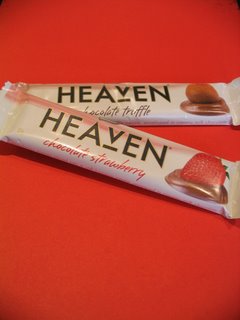
First there was Heaven on a stick. Then came Heaven in a tub. Now there's Heaven in a bar and Heaven in a block.
The Heaven ice-cream range (from Peters, later Nestlé Peters) was designed to counter the success of Unilever's Streets Magnum in the "premium impulse" category in the early 1990s. In 2005, after lagging Magnum in terms of sales and share for a long time and never really capturing consumers' hearts and minds, Heaven was re-launched in new packaging designed to communicate "premium", with high-quality "foodie" imagery (and, at the same time, to put more distance between it and Magnum).
But while brand identity and brand positioning may be conceived on a whiteboard or in a creative agency's persuasive proposals, the brand lives in the mind of the customer! Just because you've implemented a repositioning exercise, as Heaven has along the dimension of "indulgence", doesn't mean you have immediately respositioned the brand in the mind of the consumer.
Perhaps Nestlé thinks it can convince consumers that "Heaven = premium indulgence" simply by applying the brand to other indulgences... like chocolate. Which begs the question: why not Heaven cigars or a Heaven day-spa, as these are also considered premium indulgences by many?
Firstly, this strategy assumes that Heaven has strong brand awareness and preference in the categories it's already in, and if this WASN'T the case in late 2005 when they re-launched the packaging, then it's hard to believe that it IS the case barely six months later. Brand equity and brand associations take time to build.
Second, it's likely that many consumers still think of Heaven as a Peters sub-brand, like the Peters Drumstick. Nestle has retro-fitted the Nestlé parent brand name to Peters only since it bought Peters from Pacific Brands (as it has with Life Savers, Anticol, etc.). But the new Heaven chocolate extensions just say "Nestlé", that is, there's no "Peters".
And then there's cannibalisation. Nestlé's Kit Kat is also being extended in the direction of "indulgence" in the form of Kit Kat "Temptations", as we've noted here previously. Assuming that Australian consumers have a finite demand for chocolate confectionery, something's gotta give. In order to buy "premium indulgent" Heaven chocolate, people have to NOT buy another brand of chocolate, even if they move up-market (e.g. from regular Kit Kat or Aero or a Wonka bar - all Nestlé brands). Where will Heaven's share come from in chocolate? Does Heaven know? What is the risk that one Nestlé brand will simply eat another?
On the other hand, I suppose Nestlé may argue that the extensions, through their feedback effects, will help to better define the meaning of the Heaven brand for consumers. Seems like a long shot to me...
PS: While I seem to rant a lot about injudicious brand extensions at Nestlé, please don't think that (a) I have something against the Nestlé company and the people who work there, or (b) I think they are the only FMCG company suffering from hyper-extension-osis. However, I do think one can infer from the conduct of Nestlé globally (and not only in Australia) that people very high up in the firm have a very strong belief in the power of the brand (which I support), coupled with a very narrow, uni-directional and short-term notion of how brand equity should be exploited (which I think is dangerous).
UPDATE 7 MAY 2006: Just checked on IP Australia's ATMOSS Trade Marks database: Effem Foods (Mars, Inc.) has a registered mark in Class 30 that includes the words "Dove Heavenly White" for white chocolate, and Aldi Stores also have a Trade Mark application under examination for "Hazelnut Heaven" in Class 30. Could be interesting...!

No comments:
Post a Comment